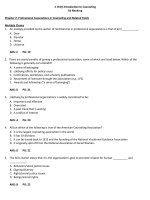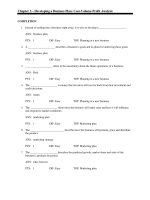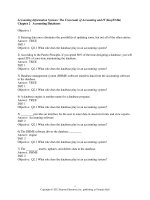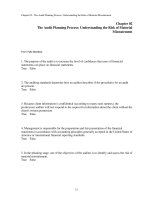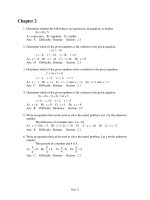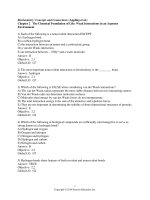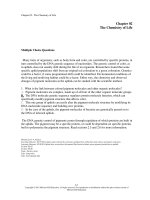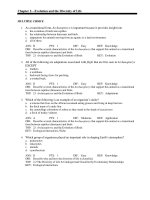Biology the essentials 1st edition hoefnagels test bank
Bạn đang xem bản rút gọn của tài liệu. Xem và tải ngay bản đầy đủ của tài liệu tại đây (104.31 KB, 37 trang )
Chapter 02 - The Chemistry of Life
Chapter 02
The Chemistry of Life
Multiple Choice Questions
1. The primary elements making up living organisms are
A. carbon, hydrogen, oxygen, and calcium.
B. carbon, oxygen, iron, and chlorine.
C. carbon, hydrogen, iron, and calcium.
D. carbon, hydrogen, oxygen, and nitrogen.
E. carbon, oxygen, sulfur, and calcium.
Bloom's Level: 1. Remember
Learning Outcome: 02.01.01 Identify the most important elements in living organisms.
Section: 02.01
Topic: Chemistry
2. The atomic number of an atom or element is
A. the number of neutrons in the nucleus.
B. the number of electrons in the nucleus.
C. the number of protons in the nucleus.
D. the number of neutrons in the orbitals.
E. the number of protons in the orbitals.
Bloom's Level: 1. Remember
Learning Outcome: 02.01.02 Describe the structure of atoms.
Section: 02.01
Topic: Chemistry
2-1
Chapter 02 - The Chemistry of Life
3. An ion is
A. an atom that has gained electrons.
B. an atom that has a positive charge.
C. an atom that has lost electrons.
D. an atom that has a negative charge.
E. All answers are correct.
Bloom's Level: 1. Remember
Learning Outcome: 02.01.02 Describe the structure of atoms.
Section: 02.01
Topic: Chemistry
4. The mass number of an atom is defined as
A. the total number of protons, neutrons, and electrons of an atom.
B. the total number of protons and electrons of an atom.
C. the total number of protons and neutrons of an atom.
D. the total number of neutrons and electrons of an atom.
E. the total number of protons of an atom.
Bloom's Level: 1. Remember
Learning Outcome: 02.01.02 Describe the structure of atoms.
Section: 02.01
Topic: Chemistry
5. Isotopes of the same element are different from one another in that
A. they have a different number of protons.
B. they have a different number of neutrons.
C. they have a different number of electrons.
D. they are a different element.
E. only one of the isotopes is matter.
Bloom's Level: 1. Remember
Learning Outcome: 02.01.02 Describe the structure of atoms.
Section: 02.01
Topic: Chemistry
2-2
Chapter 02 - The Chemistry of Life
6. The first energy shell of an atom contains a maximum of
A. one electron.
B. two electrons.
C. four electrons.
D. eight electrons.
E. sixteen electrons.
Bloom's Level: 1. Remember
Learning Outcome: 02.01.02 Describe the structure of atoms.
Section: 02.01
Topic: Chemistry
7. If an atom has a valence shell that is full, then it
A. is highly reactive.
B. is chemically unstable.
C. is highly likely to combine with other atoms.
D. is found only in a gas form.
E. is inert.
Bloom's Level: 1. Remember
Learning Outcome: 02.01.02 Describe the structure of atoms.
Section: 02.01
Topic: Chemistry
8. The second energy shell of an atom contains a maximum of
A. eight electrons.
B. two electrons.
C. four electrons.
D. one electron.
E. sixteen electrons.
Bloom's Level: 1. Remember
Learning Outcome: 02.01.02 Describe the structure of atoms.
Section: 02.01
Topic: Chemistry
2-3
Chapter 02 - The Chemistry of Life
9. In a covalent bond
A. atoms share electrons.
B. atoms of opposite charges attract each other.
C. atoms share protons.
D. atoms share neutrons.
E. atoms are repelled by each other.
Bloom's Level: 1. Remember
Learning Outcome: 02.02.01 Compare and contrast the different types of bonds.
Section: 02.02
Topic: Chemistry
10. An ionic bond is a bond in which
A. atoms share electrons.
B. atoms share protons.
C. atoms of opposite charges attract each other.
D. atoms share neutrons.
E. atoms are repelled by each other.
Bloom's Level: 1. Remember
Learning Outcome: 02.02.01 Compare and contrast the different types of bonds.
Section: 02.02
Topic: Chemistry
2-4
Chapter 02 - The Chemistry of Life
11. In the example of ionic bond formation between sodium and chlorine, which of the
following is a false statement?
A. Na is the chemical symbol for sodium.
B. Chlorine donates an electron.
C. Chlorine becomes negatively charged.
D. Sodium becomes positively charged.
E. The bond that is formed is a strong bond.
Bloom's Level: 1. Remember
Learning Outcome: 02.02.01 Compare and contrast the different types of bonds.
Section: 02.02
Topic: Chemistry
12. In the example of ionic bond formation between sodium and chlorine
A. Na is the chemical symbol for chlorine.
B. sodium accepts an electron.
C. chlorine accepts an electron.
D. chlorine becomes positively charged.
E. both sodium and chlorine accept electrons.
Bloom's Level: 1. Remember
Learning Outcome: 02.02.01 Compare and contrast the different types of bonds.
Section: 02.02
Topic: Chemistry
2-5
Chapter 02 - The Chemistry of Life
13. If a covalent bond is polar
A. electrons are not shared by atoms.
B. protons are shared by atoms.
C. it will not form in living organisms.
D. electronegativity of atoms is unequal in their pull on electrons.
E. the bond is weak in strength.
Bloom's Level: 1. Remember
Learning Outcome: 02.02.01 Compare and contrast the different types of bonds.
Section: 02.02
Topic: Chemistry
14. A hydrogen bond
A. is generally a strong bond.
B. does not occur in living organisms.
C. does not require electron transfer.
D. forms between atoms having the same electronegativity.
E. is a specialized type of covalent bond.
Bloom's Level: 1. Remember
Learning Outcome: 02.02.01 Compare and contrast the different types of bonds.
Section: 02.02
Topic: Chemistry
2-6
Chapter 02 - The Chemistry of Life
15. Evaporation is
A. the conversion of a liquid into a vapor.
B. the conversion of a solid into a vapor.
C. the conversion of a vapor into a liquid.
D. the conversion of a vapor into a solid.
E. All answers are correct.
Bloom's Level: 1. Remember
Learning Outcome: 02.03.01 Explain how the structure of water affects its chemical
properties.
Section: 02.03
Topic: Chemistry
16. Ice floats on liquid water because
A. the molecules are closer together in ice than in liquid water.
B. the molecules are farther apart in ice than in liquid water.
C. ice is denser than liquid water.
D. convection currents caused by temperature differences push upwards on the ice.
E. water vapor is less dense than liquid water.
Bloom's Level: 1. Remember
Learning Outcome: 02.03.01 Explain how the structure of water affects its chemical
properties.
Section: 02.03
Topic: Chemistry
2-7
Chapter 02 - The Chemistry of Life
17. In a chemical equation
A. the reactants are on the right of the yields arrow.
B. reactants and products are on both sides of the yields arrow.
C. the products are on the left of the yields arrow.
D. the reactants are on the left of the yields arrow.
E. the number of atoms of each element may differ on the two sides of the yields arrow.
Bloom's Level: 1. Remember
Learning Outcome: 02.02.01 Compare and contrast the different types of bonds.
Section: 02.02
Topic: Chemistry
18. An acid
A. has a value above seven on the pH scale.
B. is a chemical that takes hydrogen ions from a solution.
C. has a value of seven on the pH scale.
D. is a chemical that adds hydrogen ions to a solution.
E. All answers are correct.
Bloom's Level: 1. Remember
Learning Outcome: 02.04.01 Explain how acids and bases affect pH.
Section: 02.04
Topic: Chemistry
19. A base
A. has a value of 7 on the pH scale.
B. is a chemical that adds hydrogen ions to a solution.
C. is a chemical that absorbs hydrogen ions from a solution.
D. has a value below 7 on the pH scale.
Bloom's Level: 1. Remember
Learning Outcome: 02.04.01 Explain how acids and bases affect pH.
Section: 02.04
Topic: Chemistry
2-8
Chapter 02 - The Chemistry of Life
20. A substance with a pH of 2 is
A. neutral.
B. a weak acid.
C. a weak base.
D. a strong base.
E. a strong acid.
Bloom's Level: 1. Remember
Learning Outcome: 02.04.01 Explain how acids and bases affect pH.
Section: 02.04
Topic: Chemistry
21. A substance with a pH of 6 is
A. a weak acid.
B. neutral.
C. a weak base.
D. a strong acid.
E. a strong base.
Bloom's Level: 1. Remember
Learning Outcome: 02.04.01 Explain how acids and bases affect pH.
Section: 02.04
Topic: Chemistry
22. A substance with a pH of 7 is
A. a weak acid.
B. a weak base.
C. neutral.
D. a strong acid.
E. a strong base.
Bloom's Level: 1. Remember
Learning Outcome: 02.04.01 Explain how acids and bases affect pH.
Section: 02.04
Topic: Chemistry
2-9
Chapter 02 - The Chemistry of Life
23. A substance with a pH of 8 is
A. neutral.
B. a weak base.
C. a weak acid.
D. a strong acid.
E. a strong base.
Bloom's Level: 1. Remember
Learning Outcome: 02.04.01 Explain how acids and bases affect pH.
Section: 02.04
Topic: Chemistry
24. A substance with a pH of 13 is
A. a weak acid.
B. a weak base.
C. neutral.
D. a strong acid.
E. a strong base.
Bloom's Level: 1. Remember
Learning Outcome: 02.04.01 Explain how acids and bases affect pH.
Section: 02.04
Topic: Chemistry
25. Organic molecules are defined as chemical compounds that contain
A. hydrophilic solutions.
B. isotopes of carbon.
C. ionically bonded atoms.
D. strong hydrogen bonds.
E. carbon and hydrogen.
Bloom's Level: 1. Remember
Learning Outcome: 02.05.01 Explain the relationship between monomers and polymers.
Section: 02.05
Topic: Chemistry
2-10
Chapter 02 - The Chemistry of Life
26. The four major groups of organic compounds are
A. fats, waxes, carbohydrates, and amino acids.
B. carbohydrates, lipids, steroids, and monosaccharides.
C. lipids, fats, waxes, and steroids.
D. carbohydrates, lipids, proteins, and nucleic acids.
E. carbohydrates, proteins, amino acids, and nucleic acids.
Bloom's Level: 1. Remember
Learning Outcome: 02.05.01 Explain the relationship between monomers and polymers.
Section: 02.05
Topic: Chemistry
27. A process by which cells build large molecules from monomers is
A. hydrolysis.
B. reproduction.
C. dehydration synthesis.
D. hydrolysis and dehydration synthesis.
E. unrelated to chemical bonds.
Bloom's Level: 1. Remember
Learning Outcome: 02.05.01 Explain the relationship between monomers and polymers.
Section: 02.05
Topic: Chemistry
2-11
Chapter 02 - The Chemistry of Life
28. A process by which cells break polymers down into smaller units is
A. hydrolysis.
B. dehydration synthesis.
C. reproduction.
D. hydrolysis and dehydration synthesis.
E. unrelated to chemical bonds.
Bloom's Level: 1. Remember
Learning Outcome: 02.05.02 Compare and contrast the structures and functions of the four
classes of biological molecules.
Section: 02.05
Topic: Chemistry
29. Examples of monosaccharides are
A. cellulose and sucrose.
B. lactose and sucrose.
C. glucose and fructose.
D. glucose and cellulose.
E. None of the answers are correct.
Bloom's Level: 1. Remember
Learning Outcome: 02.05.02 Compare and contrast the structures and functions of the four
classes of biological molecules.
Section: 02.05
Topic: Chemistry
2-12
Chapter 02 - The Chemistry of Life
30. Which of the following is not a lipid?
A. a triglyceride
B. a phospholipid
C. a wax
D. a sterol
E. a starch molecule
Bloom's Level: 1. Remember
Learning Outcome: 02.05.02 Compare and contrast the structures and functions of the four
classes of biological molecules.
Section: 02.05
Topic: Chemistry
31. The primary building block (monomer) of proteins is
A. a glucose molecule.
B. a fatty acid.
C. a nucleotide.
D. an amino acid.
E. four interconnected rings.
Bloom's Level: 1. Remember
Learning Outcome: 02.05.02 Compare and contrast the structures and functions of the four
classes of biological molecules.
Section: 02.05
Topic: Chemistry
2-13
Chapter 02 - The Chemistry of Life
32. An amino acid contains
A. three R groups and a glycerol.
B. nitrogen, carbon, and an R group.
C. multiple saccharide rings.
D. carbon and phosphorus monomers.
E. carbon and phosphorus.
Bloom's Level: 1. Remember
Learning Outcome: 02.05.02 Compare and contrast the structures and functions of the four
classes of biological molecules.
Section: 02.05
Topic: Chemistry
33. A peptide bond
A. is an ionic bond in proteins.
B. is a covalent bond in carbohydrates.
C. is a covalent bond in proteins.
D. is an ionic bond in carbohydrates.
E. is a hydrogen bond in nucleic acids.
Bloom's Level: 1. Remember
Learning Outcome: 02.05.02 Compare and contrast the structures and functions of the four
classes of biological molecules.
Section: 02.05
Topic: Chemistry
2-14
Chapter 02 - The Chemistry of Life
34. The primary building block (monomer) of nucleic acids is
A. a nucleotide.
B. a glucose molecule.
C. a fatty acid.
D. an amino acid.
E. four interconnected carbon rings.
Bloom's Level: 1. Remember
Learning Outcome: 02.05.02 Compare and contrast the structures and functions of the four
classes of biological molecules.
Section: 02.05
Topic: Chemistry
35. The three major components in a nucleotide are
A. glucose, a nitrogen base, and a phosphate group.
B. glucose, a fatty acid, and glycerol.
C. a nitrogen base, a carboxyl group, and an R group.
D. a nitrogen base, a five-carbon sugar, and a phosphate group.
E. a carboxyl group, an R group, and an amino group.
Bloom's Level: 1. Remember
Learning Outcome: 02.05.02 Compare and contrast the structures and functions of the four
classes of biological molecules.
Section: 02.05
Topic: Chemistry
2-15
Chapter 02 - The Chemistry of Life
36. The four nitrogenous bases found in RNA are
A. glycerol, phosphate, adenine, and glucose.
B. adenine, cytosine, guanine, and uracil.
C. adenine, thymine, cytosine, and uracil.
D. thymine, cytosine, guanine, and uracil.
E. adenine, thymine, guanine, and cytosine.
Bloom's Level: 1. Remember
Learning Outcome: 02.05.02 Compare and contrast the structures and functions of the four
classes of biological molecules.
Section: 02.05
Topic: Chemistry
37. Water is best described as which of the following?
A. an ion
B. a non-polar molecule
C. an atom
D. a polar molecule
E. an element
Bloom's Level: 2. Understand
Learning Outcome: 02.03.01 Explain how the structure of water affects its chemical
properties.
Section: 02.03
Topic: Chemistry
2-16
Chapter 02 - The Chemistry of Life
38. Individual water molecules bind to each other with
A. covalent bonds.
B. ionic bonds.
C. hydrogen bonds.
D. hydrophobic bonds.
E. peptide bonds.
Bloom's Level: 2. Understand
Learning Outcome: 02.03.01 Explain how the structure of water affects its chemical
properties.
Section: 02.03
Topic: Chemistry
39. Within a single molecule of water, ____ bonds are formed between oxygen and
hydrogen.
A. ionic
B. covalent
C. hydrogen
D. hydrophobic
E. nuclear
Bloom's Level: 2. Understand
Learning Outcome: 02.03.01 Explain how the structure of water affects its chemical
properties.
Section: 02.03
Topic: Chemistry
2-17
Chapter 02 - The Chemistry of Life
40. What do a lemon, a toaster oven, and sand grains have in common?
A. All are composed of matter and energy.
B. All are alive.
C. All are composed of organic molecules.
D. All are acidic.
E. All are basic.
Bloom's Level: 3. Apply
Learning Outcome: 02.00.01 Explain the chemical nature of biological molecules.
Section: 02.01
Topic: Chemistry
41. You can painlessly wade into a pool, but doing a belly flop off of the high diving board
hurts because of ______.
A. water's high density
B. adhesion of your molecules with the water molecules
C. water's high boiling point
D. a neutral pH
E. cohesion of the water molecules
Bloom's Level: 3. Apply
Learning Outcome: 02.03.01 Explain how the structure of water affects its chemical
properties.
Section: 02.03
Topic: Chemistry
2-18
Chapter 02 - The Chemistry of Life
42. Trees are able to transport water hundreds of feet up from the roots because of
A. water's high density.
B. cohesion of the water molecules.
C. water's high boiling point.
D. adhesion of tree molecules with the water molecules.
E. a neutral pH.
Bloom's Level: 3. Apply
Learning Outcome: 02.03.01 Explain how the structure of water affects its chemical
properties.
Section: 02.03
Topic: Chemistry
43. Sugars (CH2O)n dissolve well in water and are therefore called ______ substances.
A. covalent
B. ionic
C. hydrogen
D. hydrophobic
E. hydrophilic
Bloom's Level: 3. Apply
Learning Outcome: 02.03.01 Explain how the structure of water affects its chemical
properties.
Section: 02.03
Topic: Chemistry
2-19
Chapter 02 - The Chemistry of Life
44. Blood pH is closely maintained at a pH of 7.4. A patient whose blood pH drops below
7.35 is suffering from metabolic acidosis and can go into a coma. What happens to the
concentration of H+ ions in a patient with a blood pH of 6.4?
A. H+ concentration is decreased 10-fold.
B. H+ concentration is decreased 2-fold.
C. H+ concentration is increased 2-fold.
D. H+ concentration is decreased 4-fold.
E. H+ concentration is increased 10-fold.
Bloom's Level: 3. Apply
Learning Outcome: 02.04.01 Explain how acids and bases affect pH.
Section: 02.04
Topic: Chemistry
Scientists use carbon dating to determine the age of fossils. 14C is a rare isotope of carbon
that has a half life of 5730 years and decays into 14N. By measuring the amount of 14C
remaining in a fossil, scientists can estimate when the organism died to within 60,000 years.
The atomic numbers of C is 6 and of N is 7.
45. 14C and 14N are both
A. atoms.
B. molecules.
C. compounds.
D. polymers.
E. ions.
Bloom's Level: 2. Understand
Learning Outcome: 02.02.02 Differentiate between atoms, molecules, and compounds.
Section: 02.02
Topic: Chemistry
2-20
Chapter 02 - The Chemistry of Life
46. The most common isotope of carbon is 12C. 14C has ____ than 12C.
A. more protons
B. more neutrons
C. fewer neutrons
D. fewer protons
E. more electrons
Bloom's Level: 3. Apply
Learning Outcome: 02.01.02 Describe the structure of atoms.
Section: 02.01
Topic: Chemistry
47. 14C and 14N have the same
A. atomic number.
B. number of protons.
C. atomic mass.
D. number of neutrons.
E. number of electrons.
Bloom's Level: 4. Analyze
Learning Outcome: 02.01.02 Describe the structure of atoms.
Section: 02.01
Topic: Chemistry
48. Which of the following is NOT an example of matter?
A. wind
B. energy
C. light
D. sound
E. None of the answers are correct.
Bloom's Level: 3. Apply
Learning Outcome: 02.00.01 Explain the chemical nature of biological molecules.
Section: 02.01
Topic: Chemistry
2-21
Chapter 02 - The Chemistry of Life
49. Hydrogen, nitrogen, carbon, and oxygen account for 96% of the human body. These
elements are
A. also the main elements in organic molecules.
B. rare in non-human organisms.
C. rare on Earth.
D. always bonded by hydrogen bonds.
E. All answers are correct.
Bloom's Level: 3. Apply
Learning Outcome: 02.01.01 Identify the most important elements in living organisms.
Section: 02.01
Topic: Chemistry
50. Many digestive enzymes are hydrolases which carry out hydrolysis. What do these
enzymes have in common?
A. They use water to form bonds between monomers.
B. They use water to break bonds in monomers.
C. They use water to break bonds in polymers.
D. They use water to form bonds between polymers.
E. They release water in forming bonds between monomers.
Bloom's Level: 3. Apply
Learning Outcome: 02.05.01 Explain the relationship between monomers and polymers.
Section: 02.05
Topic: Chemistry
2-22
Chapter 02 - The Chemistry of Life
51. ____ bonds are formed between monomers to form a polymer.
A. Ionic
B. Covalent
C. Hydrogen
D. Hydrophobic
E. Nuclear
Bloom's Level: 2. Understand
Learning Outcome: 02.05.01 Explain the relationship between monomers and polymers.
Section: 02.05
Topic: Chemistry
52. Hydrogen has 1 proton, 0 neutrons, and 1 electron. Which of the following is correct
about hydrogen?
A. Hydrogen has an atomic number of 1.
B. Hydrogen has an atomic number of 2.
C. Hydrogen has an atomic mass of 2.
D. Hydrogen has an atomic number and atomic mass of 2.
E. Hydrogen has an atomic number and atomic mass of 1.
Bloom's Level: 3. Apply
Learning Outcome: 02.01.02 Describe the structure of atoms.
Section: 02.01
Topic: Chemistry
2-23
Chapter 02 - The Chemistry of Life
53. Saturated fats have long straight tails of fatty acids, while unsaturated fats have kinks in
their tails created by the double bonds. The kinks prevent the fatty acids from packing
together as tightly. Ectothermic (cold blooded) animals need to keep their membranes fluid at
cooler temperature and thus contain ______ their membranes.
A. mostly unsaturated fats in
B. mostly saturated fats in
C. no fatty acids in
D. a cell wall around
E. no lipids in
Bloom's Level: 3. Apply
Learning Outcome: 02.05.02 Compare and contrast the structures and functions of the four
classes of biological molecules.
Section: 02.05
Topic: Chemistry
54. Saturated fats have long straight tails of fatty acids, while unsaturated fats have kinks in
their tails created by the double bonds. The kinks prevent the fatty acids from packing
together as tightly. Hydrogenated vegetable oils have hydrogens added back to the double
bonds and thus behave like ____.
A. unsaturated fats
B. waxes
C. carbohydrates
D. protein
E. saturated fats
Bloom's Level: 3. Apply
Learning Outcome: 02.05.02 Compare and contrast the structures and functions of the four
classes of biological molecules.
Section: 02.05
Topic: Chemistry
2-24
Chapter 02 - The Chemistry of Life
55. The polymers with the most complex and diverse three-dimensional structures are
A. saturated fats.
B. unsaturated fats.
C. proteins.
D. waxes.
E. carbohydrates.
Bloom's Level: 2. Understand
Learning Outcome: 02.05.02 Compare and contrast the structures and functions of the four
classes of biological molecules.
Section: 02.05
Topic: Chemistry
56. A nucleotide contains which of the following?
A. amino acid and nitrogenous bases
B. saturated and unsaturated fatty acids
C. sugar, nitrogenous base, and phosphate
D. amino acid and saccharide
E. fatty acid, glycerol, and phosphate
Bloom's Level: 2. Understand
Learning Outcome: 02.05.02 Compare and contrast the structures and functions of the four
classes of biological molecules.
Section: 02.05
Topic: Chemistry
2-25
